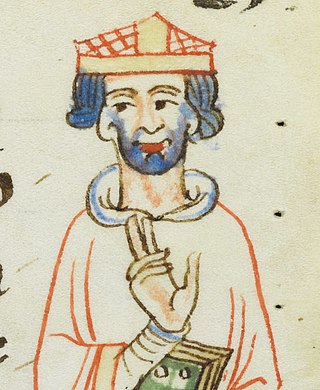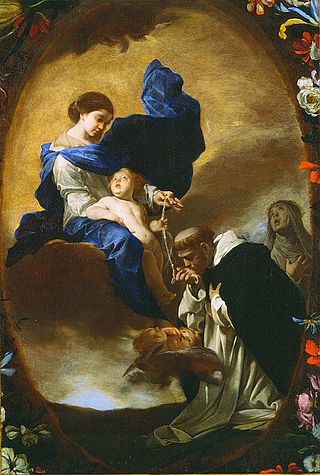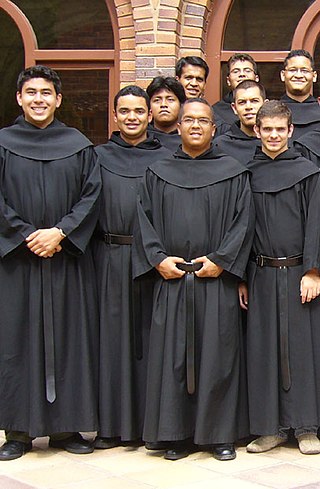
The Order of Preachers abbreviated OP, also known as the Dominicans, is a Catholic mendicant order of pontifical right founded in France, by a Spanish priest, saint and mystic, Dominic. It was approved by Pope Honorius III via the papal bull Religiosam vitam on 22 December 1216. Members of the order, who are referred to as Dominicans, generally carry the letters OP after their names, standing for Ordinis Praedicatorum, meaning of the Order of Preachers. Membership in the order includes friars, nuns, active sisters, and lay or secular Dominicans. More recently there has been a growing number of associates of the religious sisters who are unrelated to the tertiaries.

Pope Honorius III, born Cencio Savelli, was head of the Catholic Church and ruler of the Papal States from 18 July 1216 to his death. A canon at the Basilica di Santa Maria Maggiore, he came to hold a number of important administrative positions, including that of Camerlengo. In 1197, he became tutor to the young Frederick II. As pope, he worked to promote the Fifth Crusade, which had been planned under his predecessor, Innocent III. Honorius repeatedly exhorted King Andrew II of Hungary and Emperor Frederick II to fulfill their vows to participate. He also gave approval to the recently formed Dominican and Franciscan religious orders.

The Rosary, also known as the Dominican Rosary, refers to a set of prayers used primarily in the Catholic Church, and to the physical string of knots or beads used to count the component prayers. When referring to the prayer, the word is usually capitalized ; when referring to the prayer beads as an object, it is written with a lower-case initial letter.

The Albigensian Crusade or the Cathar Crusade was a military and ideological campaign initiated by Pope Innocent III to eliminate Catharism in Languedoc, southern France. The Crusade was prosecuted primarily by the French crown and promptly took on a political aspect. It resulted in the significant reduction of practicing Cathars and a realignment of the County of Toulouse with the French crown. The distinct regional culture of Languedoc was also diminished.

A friar is a member of one of the mendicant orders founded in the twelfth or thirteenth century; the term distinguishes the mendicants' itinerant apostolic character, exercised broadly under the jurisdiction of a superior general, from the older monastic orders' allegiance to a single monastery formalized by their vow of stability. A friar may be in holy orders or a brother. The most significant orders of friars are the Dominicans, Franciscans, Augustinians, and Carmelites.

The Basilica of Saint Sabina is a historic church on the Aventine Hill in Rome, Italy. It is a titular minor basilica and mother church of the Roman Catholic Order of Preachers, better known as the Dominicans.

Saint Dominic,, also known as Dominic de Guzmán, was a Castilian Catholic priest, mystic, the founder of the Dominican Order and is the patron saint of astronomers and natural scientists. He is alternatively called Dominic of Osma, Dominic of Caleruega, and Domingo Félix de Guzmán.

Eucharistic adoration is a Eucharistic devotional practice primarily in Western Catholicism, but also to a lesser extent in certain Lutheran and Anglican traditions, in which the Blessed Sacrament is adored by the faithful. This practice may occur either when the Eucharist is exposed, or when it is not publicly viewable because it is reserved in a place such as a church tabernacle.
The Passionists, officially named Congregation of the Passion of Jesus Christ, abbreviated CP, is a Catholic clerical religious congregation of Pontifical Right for men, founded by Paul of the Cross in 1720 with a special emphasis on and devotion to the Passion of Jesus Christ. A known symbol of the congregation is the labeled emblem of the Sacred Heart of Jesus, surmounted by a cross and is often sewn into the attire of its congregants.
The Order of the Blessed Virgin Mary, also called the Order of Saint Mary of the Tower or the Order of the Knights of the Mother of God, commonly the Knights of Saint Mary, was a military order founded in 1261. The order received its rule from Pope Urban IV, who expressly states the purpose of the organisation and the rights and obligations of its members:
[The members of the order] are to be allowed to bear arms for the defence of the catholic faith and ecclesiastical freedom, when specifically required to do so by the Roman church. For subduing civil discords they may carry only defensive weapons, provided they have the permission of the diocesan.

Jordan of Saxony, OP, was a German Catholic priest and one of the first leaders of the Dominican Order. His feast day is February 13.

Catholic spirituality includes the various ways in which Catholics live out their Baptismal promise through prayer and action. The primary prayer of all Catholics is the Eucharistic liturgy in which they celebrate and share their faith together, in accord with Jesus' instruction: "Do this in memory of me." The Catholic bishops at the Second Vatican Council decreed that "devotions should be so drawn up that they harmonize with the liturgical seasons, accord with the sacred liturgy, are in some fashion derived from it, and lead the people to it, since, in fact, the liturgy by its very nature far surpasses any of them." In accord with this, many additional forms of prayer have developed over the centuries as means of animating one's personal Christian life, at times in gatherings with others. Each of the religious orders and congregations of the Catholic church, as well as lay groupings, has specifics to its own spirituality – its way of approaching God in prayer to foster its way of living out the Gospel.
Conrad of Urach was a Cistercian monk and abbot, and Cardinal Bishop of Porto and Santa Rufina; he declined the papacy.
The Dominican Nuns of the Perpetual Rosary are a religious institute founded in 1880 in Calais, France, by Father Damien-Marie Saintourens, Mother Rose of Saint Mary Werhle and Mother Mary Imelda Gauthier, all of them from the Order of the Preachers.

The Third Order of Saint Dominic, also referred to as the Lay Fraternities of Saint Dominic or Lay Dominicans since 1972, is a Roman Catholic third order affiliated with the Dominican Order.

Religiosam vitam is the incipit designating a papal bull issued on 22 December 1216 by Pope Honorius III. It gave universal recognition to the Dominican Order. The order already had monasteries in Rome, Paris and Boulogne and had already been locally recognized by the bishop of Toulouse the year before – its creation had coincided with the Albigensian Crusade in southern France, in whose support the Dominicans had been very active. It adopted the Rule of St Augustine, but was also regulated by rulings and decisions taken by its own regular general chapters.
The Militia of Jesus Christ was a military order in Lombardy during the High Middle Ages. It was founded at Parma by Bartholomew, Bishop of Vicenza, a Dominican, in 1233 and approved by Pope Gregory IX, who gave it a rule in 1234 and placed under the jurisdiction of the Dominicans. Its chief purpose was to combat heresy, like Catharism and Waldensianism, and to strengthen the bond between the Roman Church and the local nobility. In imitation of the Order of Santiago, members of the Militia did not take a vow of chastity, nor did they live communally or in poverty.

The Order of Monfragüe was a Spanish military order founded at the castle of Monfragüe near Plasencia on the Tagus in 1196. The order was founded by the knights of the Order of Mountjoy who dissented from a merger with the Knights Templar. The order never prospered and on 23 May 1221, by order of Ferdinand III of Castile, it was merged into the Order of Calatrava.

Throughout history, Catholic Mariology has been influenced by a number of saints who have attested to the central role of Mary in God's plan of salvation. The analysis of Early Church Fathers continues to be reflected in modern encyclicals. Irenaeus vigorously defended the title of "Theotokos" or Mother of God. The views of Anthony of Padua, Robert Bellarmine and others supported the doctrine of the Immaculate Conception of the Virgin Mary, which was declared a dogma in 1850.

The orders, decorations, and medals of the Holy See include titles, chivalric orders, distinctions and medals honoured by the Holy See, with the Pope as the fount of honour, for deeds and merits of their recipients to the benefit of the Holy See, the Catholic Church, or their respective communities, societies, nations and the world at large.